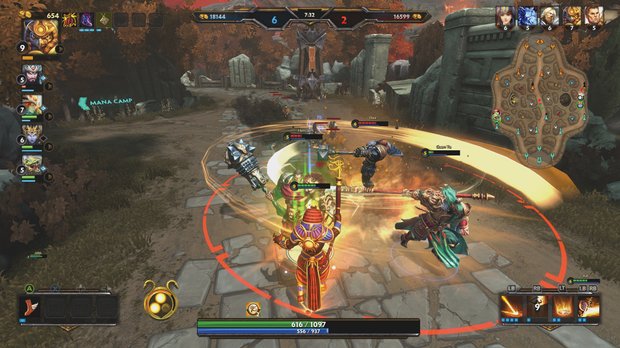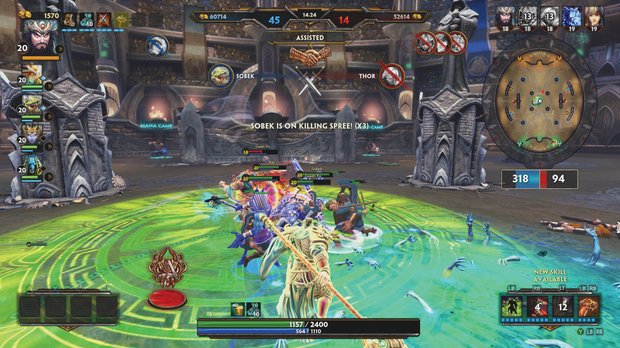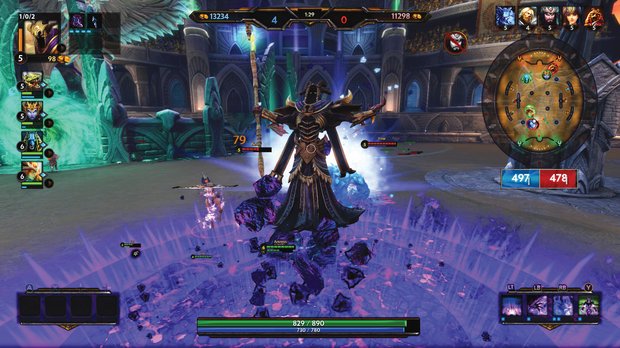Have you ever used ‘jungle’ as a verb? How about ‘gank’? Do you appreciate the strategic grace of a ‘dramatic rotation’ or shudder at the thought of a ‘greedy dive’? If not, that is perfectly reasonable. You’ve lived your life without exposure to the MOBA’s affinity for nonsense, the intricate secret language shared by devotees of the competitive gaming world’s most complicated – and, conversely, most popular – genre. Soon, that will change. Smite is the third most popular MOBA on PC, and it’s coming to Xbox One this year. It’s time to learn what it means to jungle.
It’s best to start with the basics. Smite is a third-person competitive action-RPG where each player controls a different mythological god. There are more than 60 characters, and they each control broadly similarly – movement and vision on the thumbsticks, attacks on the right trigger. Beyond that, however, things get more interesting.

Some gods have ranged attacks; others are restricted to melee. Every god has four special abilities, which are mapped to the face buttons, as well as an always-on ‘passive’ ability. You also have an inventory, which you fill over the course of a match with items that boost your various attributes. Finally, there are ‘active’ items – devices that add new abilities, such as teleportation or brief immunity to incoming damage. Teams of these gods battle over objectives that vary from mode to mode, map to map.
Here’s a single example – one of our favourites. Ares is the Greek god of war, rendered in Smite as a hulking hoplite with burning eyes and a shield with a face on it. He’s limited to melee attacks but can absorb a lot of damage straight out of the gate. His first ability, Shackles, allows him to throw out a chain. If it connects with an enemy it latches to them, doing damage over time, slowing them and preventing them from escaping. A successful hit gives Ares the ability to immediately fire another shackle – either at the same enemy or a different one – while if he misses he has to wait for the ability to cool down. His second ability, Bolster Defenses, grants defensive bonuses to nearby allies based on how many chains Ares has active.

For his third ability, Searing Flesh, Ares uses that face-shield as a flame thrower, doing heavy damage over time in a cone in front of him. His fourth and ‘ultimate’ ability, No Escape, is designed to control large groups of heroes. Ares jumps into the air and throws chains into every god within a certain radius. After a short delay he crashes down, dragging all of those gods towards a central point and preventing them from moving or using abilities for a few seconds. It’s a dramatic way to start a fight.
Ares’ passive ability, Blessed Presence, makes his magic abilities – like Searing Flesh – more powerful for every ‘aura’ item that he has in his inventory. These are items that grant a buff of some kind to every ally in the vicinity of the wearer. Because of this affinity for them, Ares is a natural vanguard for his team: a dispenser of buffs and bonuses, able to control enemies and set up kills for gods with punchier damage abilities. For active items, he makes best use of items that enhance his ability to chase and start fights – such as Greater Blink, which allows a god to teleport a short distance.

Here’s how all of that might work in unison. Ares spots a group of clustered enemies approaching and uses Greater Blink followed by No Escape. As they’re dragged together, he fires Shackles into the clustered mass and lands as many chains as possible. Then he uses Bolster Defenses to boost himself and any nearby allies and follows up with Searing Flesh. This might not be enough to wipe out the entire enemy team, but it’s a fantastic setup for other gods to capitalise on. That’s how just one god works. To re-emphasise: there are more than 60 of them, and more are added every couple of weeks.
Weekly digests, tales from the communities you love, and more
All of these different aspects of your character are developed over the course of a given match. Which abilities you prioritise, which items you purchase, how quickly you acquire the gold and experience necessary to do so – all of these are strategic decisions that you’ll need to consider every time you play. It sounds daunting, but the reality is more accessible than you’d expect. It’s like playing an RPG in fast-forward, experiencing a character’s entire life cycle in 40 minutes rather than 40 hours.

Hi-Rez is conscious of the need to introduce these ideas properly. “We’re looking into the best ways to make that transition easier for people” says producer Andy Anderson. “We try to walk people through. When you first load the game, it boots into the basic tutorial. We’ve got practice modes against the computer, co-op modes with other people on your own team only – before you advance to playing against other people.”
Nonetheless, there is always more information to absorb – gods and items you’re not familiar with, strategies you’ve not encountered before. Traditionally on PC, these gaps have been filled by gaming communities – writing guides and producing videos that are a Google search away at any given time. For Smite on Xbox One, Hi-Rez has decided to bring those resources into the game client itself. “The plan is to have a library of YouTube ‘quick look’ videos that give you an idea of how to use your abilities,” Anderson says. “We’ve got to break down that barrier.”

You’ve got to be willing to take on a lot of new info to get the most out of Smite, but that’s part of the game’s appeal. No other type of competitive game furnishes you with new things to learn, encounter or do quite like this. 60 characters translates to a vast amount of different ways to play, and an enormous pre-existing community to involve yourself in. It’s high time some of that made its way to Xbox.
Click here for more excellent Official Xbox Magazine articles. Or maybe you want to take advantage of some great offers on magazine subscriptions? You can find them here.
The official source for everything Xbox One, Xbox 360, and Xbox Series X. We're also a magazine, covering all things Xbox in the UK and the US. Originally established in 2001, the magazine was discontinued in April 2020.



